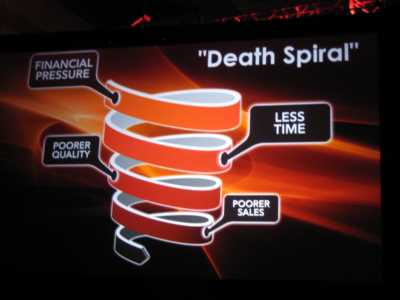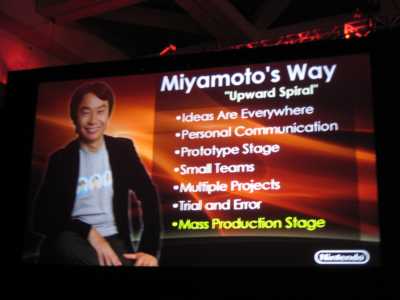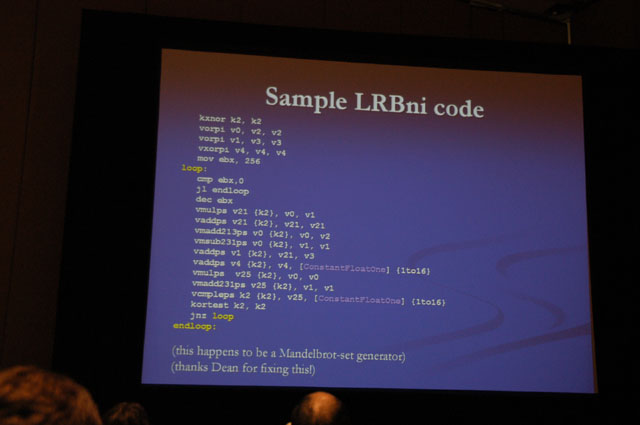Discovering New Development Opportunities – Satoru Iwata
 GDC kicked off with a keynote by Satoru Iwata, the president of Nintendo. The talk included a variety of new software announcements which you can read about in the official coverage, but to me the most interesting content was Iwata’s comments on the business of game development. He discussed how companies can fall into the “death spiral” of development where they are forced, due to financial pressure, to ship early and compromise the quality of their product. This, in turn, leads to lower sales, less money, and increased financial pressure for the next project. He then discussed how Shigeru Miyamoto’s approach to design creates an “upward spiral.”
GDC kicked off with a keynote by Satoru Iwata, the president of Nintendo. The talk included a variety of new software announcements which you can read about in the official coverage, but to me the most interesting content was Iwata’s comments on the business of game development. He discussed how companies can fall into the “death spiral” of development where they are forced, due to financial pressure, to ship early and compromise the quality of their product. This, in turn, leads to lower sales, less money, and increased financial pressure for the next project. He then discussed how Shigeru Miyamoto’s approach to design creates an “upward spiral.”
 He described how Miyamoto always has multiple, simultaneous projects in a prototype stage and that only when Miyamoto is satisfied that all the necessary elements are perfect will he allow a project to progress to the next stage. The prototype stage may take as long as two years and sometimes, when it isn’t showing progress, it is suspended and restarted later. Although Iwata tried to make this sound like a repeatable recipe for success, his talk was intertwined with comments about how Miyamoto is a genius and sees fantastic new gameplay opportunities in every aspect of life. What happens if I implement the process without a genius? Do I still end up with Super Mario Sunshine?
He described how Miyamoto always has multiple, simultaneous projects in a prototype stage and that only when Miyamoto is satisfied that all the necessary elements are perfect will he allow a project to progress to the next stage. The prototype stage may take as long as two years and sometimes, when it isn’t showing progress, it is suspended and restarted later. Although Iwata tried to make this sound like a repeatable recipe for success, his talk was intertwined with comments about how Miyamoto is a genius and sees fantastic new gameplay opportunities in every aspect of life. What happens if I implement the process without a genius? Do I still end up with Super Mario Sunshine?
Media Molecule: ‘Winging It’ – Ups, Downs, Mistakes, Successes in the Making of LittleBigPlanet – Alex Evans, Mark Healey
 I consider this talk by Alex Evans and Mark Healey to be a perfect reflection of the team at Media Molecule and the development process for LittleBigPlanet. The talk was completely unstructured and Alex and Mark admitted they hadn’t really prepared for it. Additionally, Alex doesn’t like PowerPoint so the talk was delivered on a collaborative presentation application that he wrote on the plane. Despite the two presenters frequently talking over each other and moving randomly from topic to topic, they had a certain chemistry and the talk never got boring. My takeaway from this talk is that all the principles at Media Molecule are multitalented geniuses. Everyone has an equal voice in design and they all seem to have some background in coding and some talent in art. As far as I can tell everything they touch turns to gold.
I consider this talk by Alex Evans and Mark Healey to be a perfect reflection of the team at Media Molecule and the development process for LittleBigPlanet. The talk was completely unstructured and Alex and Mark admitted they hadn’t really prepared for it. Additionally, Alex doesn’t like PowerPoint so the talk was delivered on a collaborative presentation application that he wrote on the plane. Despite the two presenters frequently talking over each other and moving randomly from topic to topic, they had a certain chemistry and the talk never got boring. My takeaway from this talk is that all the principles at Media Molecule are multitalented geniuses. Everyone has an equal voice in design and they all seem to have some background in coding and some talent in art. As far as I can tell everything they touch turns to gold.
Stop Wasting My Time and Your Money: Why Your Game Doesn’t Need a Story to be a Hit – Margaret Robertson
Margaret Robertson returned this year after her much-praised talk in 2008 Treat Me Like a Lover. Her focus this year was game stories, specifically the wasted time and money involved in pursuing them. In theory her talk was about how difficult and expensive adding story to a game is and how games don’t need stories to be good, so why bother. That isn’t really the message that came through in the content of her talk, however. She did the obligatory highlighting of bad stories in games, but she spent most of her time praising the really subtle and clever ways in which really great stories have been told in games.
 She argued that very short, simple stories can be cheaper to produce than their long-winded brethren and that they can have more impact and wider appeal. She used Hemingway’s famous six-word story as one example, “For sale: baby shoes, never worn,” but she also praised the lambda resistance decal in Half-life 2, the church turned field hospital in Eternal Darkness, and what could be The New Zealand Story‘s own entry in the six-word story contest, “a walrus has stolen my friends!” What she failed to do was convince me that coming up with good tiny stories is any easier than coming up with long ones. I’m totally convinced that the best and most effective game stories are small, immutable, and highly evocative, but I think we end up with long, convoluted, drawn-out epics because they’re far, far easier. After all, despite many attempts, in 80 years no one has come up with a six-word story to rival Hemingway’s. It’s only six words, how hard can it be?
She argued that very short, simple stories can be cheaper to produce than their long-winded brethren and that they can have more impact and wider appeal. She used Hemingway’s famous six-word story as one example, “For sale: baby shoes, never worn,” but she also praised the lambda resistance decal in Half-life 2, the church turned field hospital in Eternal Darkness, and what could be The New Zealand Story‘s own entry in the six-word story contest, “a walrus has stolen my friends!” What she failed to do was convince me that coming up with good tiny stories is any easier than coming up with long ones. I’m totally convinced that the best and most effective game stories are small, immutable, and highly evocative, but I think we end up with long, convoluted, drawn-out epics because they’re far, far easier. After all, despite many attempts, in 80 years no one has come up with a six-word story to rival Hemingway’s. It’s only six words, how hard can it be?
Rasterization on Larrabee: A First Look at the Larrabee New Instructions in Action – Michael Abrash
Mike Abrash proves that one of the most experienced and respected optimization specialists in the industry can, given enough time and pressure, invent a software rasterizer for Larrabee that is competitive with a traditional hardware solution. Woot?
 Sarcasm aside, this was a very interesting talk. Larrabee rectifies enough of the mistakes of the Cell processor that I think it actually has a future in mainstream computing, particularly game development. It isn’t so different from the Xbox 360 processor, in fact. It offers lots of parallelism and a beefed up vector unit at the cost of out-of-order execution. The hardware can’t afford to extract parallelism, the compiler isn’t smart enough to, so guess what? assembly programming is back in fashion! Luckily graphics has been dealing with the problem of high-level parallelism for about forty years and has established a framework that allows everyone–processors, compilers, and programmers–to achieve maximum parallelism with minimal effort. We can wet our feet with Larrabee the graphics platform while they figure out how to make Larrabee the general-computing platform palatable.
Sarcasm aside, this was a very interesting talk. Larrabee rectifies enough of the mistakes of the Cell processor that I think it actually has a future in mainstream computing, particularly game development. It isn’t so different from the Xbox 360 processor, in fact. It offers lots of parallelism and a beefed up vector unit at the cost of out-of-order execution. The hardware can’t afford to extract parallelism, the compiler isn’t smart enough to, so guess what? assembly programming is back in fashion! Luckily graphics has been dealing with the problem of high-level parallelism for about forty years and has established a framework that allows everyone–processors, compilers, and programmers–to achieve maximum parallelism with minimal effort. We can wet our feet with Larrabee the graphics platform while they figure out how to make Larrabee the general-computing platform palatable.
Great Games Made Easy – Adrian Stone
I’ve come away from GDC with a new understanding of what it takes to make top-tier games. First, blah blah blah; next, add a small team of passionate creative and technical geniuses; finally, blah blah blah. Wait three years and out pops Super Mario Sunshine, LittleBigPlanet, or Half-Life 2 running at 60 Hz in perfectly vectorized assembly. The only downside is you don’t get to pick the genre.
